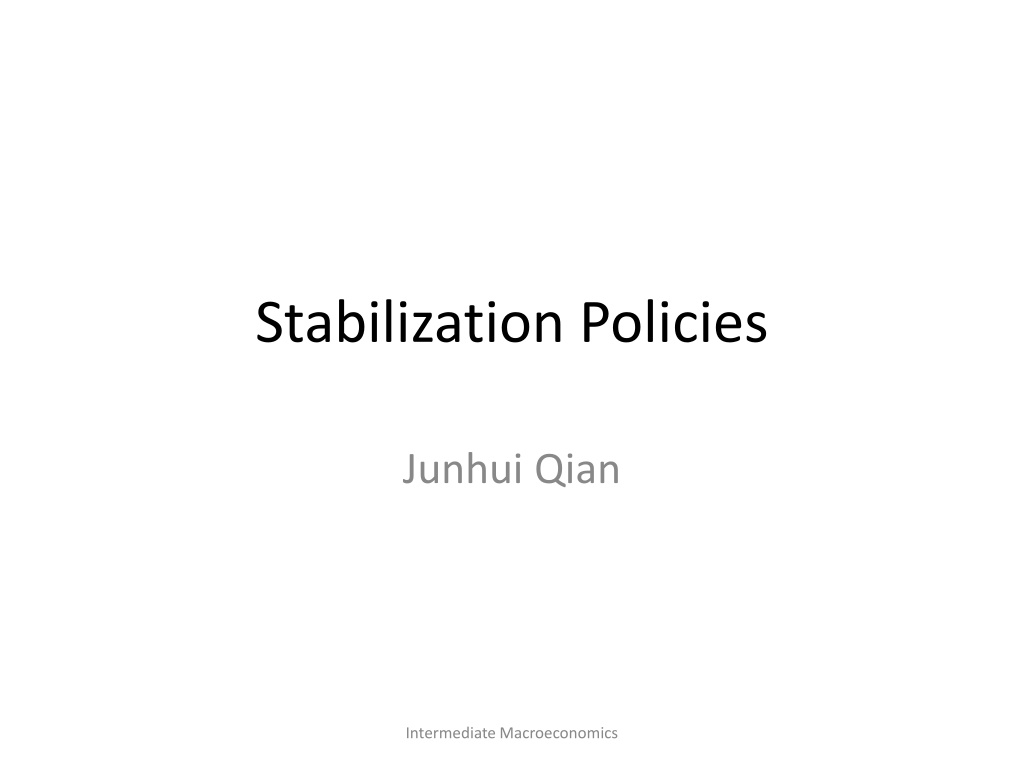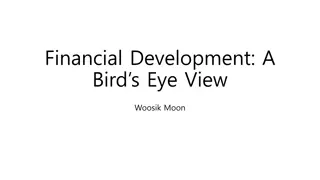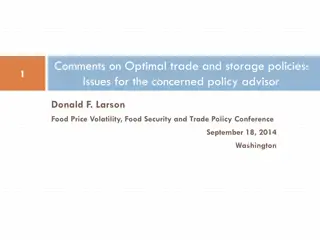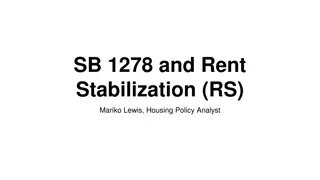Stabilization Policies
In Intermediate Macroeconomics, stabilization policies play a crucial role in managing economic fluctuations. Automatic fiscal stabilizers and discretionary fiscal policies are explored, along with the importance of financial stability. The attraction of automatic stabilizers, discretionary fiscal policy implementations, deficit and debt management considerations, Ricardian Equivalence theory, and the perils of debt are discussed. Understanding these concepts is essential for policymakers and students of macroeconomics.
Uploaded on Feb 21, 2025 | 0 Views
Download Presentation

Please find below an Image/Link to download the presentation.
The content on the website is provided AS IS for your information and personal use only. It may not be sold, licensed, or shared on other websites without obtaining consent from the author.If you encounter any issues during the download, it is possible that the publisher has removed the file from their server.
You are allowed to download the files provided on this website for personal or commercial use, subject to the condition that they are used lawfully. All files are the property of their respective owners.
The content on the website is provided AS IS for your information and personal use only. It may not be sold, licensed, or shared on other websites without obtaining consent from the author.
E N D
Presentation Transcript
Stabilization Policies Junhui Qian Intermediate Macroeconomics
Content Fiscal Automatic fiscal stabilizers Discretionary fiscal policy Monetary policy Financial stability Intermediate Macroeconomics
Automatic fiscal stabilizers Tax stabilizers Personal income tax, progressiveness EIT, VAT, or BT Spending stabilizers Unemployment insurance Other social security payments (e.g., benefits for retirees) Intermediate Macroeconomics
The Attraction of Automatic Stabilizers They work automatically, without any delay, and throughout the cycles. In contrast, discretionary policies are often delayed responses. The more stabilizers, the better. The less destabilizers , the better. Intermediate Macroeconomics
Discretionary Fiscal Policy A discretionary policy is based on the judgment of policymakers under a particular situation. Direct government expenditure Spending on infrastructure, public health, security, education, etc. Timing is important Tax cuts or incentives Intermediate Macroeconomics
Deficit and Debt Budget deficit is a flow, and debt is a stock. It is not necessary for a government to make ends meet . Government budget deficit is net income to the private sector. An increase in government debt is an increase in asset held by the private sector. Fiscal policies should be judged by the effects on the economy, not by whether the budget is balanced. Intermediate Macroeconomics
Ricardian Equivalence Since the government has to pay off the debt, the choice is tax now or tax later . Ricardian Equivalence says that, under some stringent conditions, this choice does not matter. Tax cuts would fail to stimulate demand. Intermediate Macroeconomics
Perils of Debt Interest costs may become a burden. Domestic debt Foreign debt Risk of currency crisis Intermediate Macroeconomics
Content Fiscal Automatic fiscal stabilizers Discretionary fiscal policy Monetary policy Financial stability Intermediate Macroeconomics
Monetary Instruments, Target Variable, and Objectives Intermediate Macroeconomics
Objectives Price stability Inflation-targeting Full employment Economic growth Financial market stability Exchange-rate stability. Intermediate Macroeconomics
Target Variables Intermediate target variables refer to variables that are vitally important to the economy and that are manipulable by the monetary authority. Money supply Short-term money market interest rate (short rate) Intermediate Macroeconomics
Objectives, Target Variables, and Instruments of Major Central Banks Intermediate Macroeconomics
Instruments Open Market Operations (OMO) Asset purchase/sale, repo/reverse repo Reserve Requirement Interest on Reserves (IOR) Standing Lending Facilities (SLF) Medium-term Lending Facility (MLF) Forward Guidance Window Guidance Intermediate Macroeconomics
Interest Rate Corridor Interest rate corridor (or channel) is now a common operating framework for central banks to control the short rate. The ceiling: the interest rate at which the central bank is ready to lend to banks. The floor: the interest rate at which the central bank is ready to borrow from banks. Intermediate Macroeconomics
Interest Rate Corridor Intermediate Macroeconomics
Unconventional Monetary Policy A key characteristic of the unconventional central banking since 2008 is that the central bank ensures ample supply of reserves. In the age of ample reserves, the corridor system reduces to the floor system. OMO becomes less important, while the interest rate on reserves becomes the key instrument. Intermediate Macroeconomics
The Corridor System in the Age of Ample Reserves Intermediate Macroeconomics
Monetary Policy Rule A monetary policy rule characterizes how a central bank responds, by manipulating the target variable, responds to changes in economic conditions. An empirical relation between the target variable and economic objectives (e.g., inflation and unemployment). If such a relationship is relatively stable, the rule may give some guidance for central bankers. Intermediate Macroeconomics
The Taylor rule The Taylor Rule states: federal fund rate = inflation + 2 +0.5 inflation 2 + 0.5 GDP gap Taylor Principle: the nominal interest rate should rise faster than inflation Intermediate Macroeconomics
Monetary Policy Transmission Interest-rate channel Exchange-rate channel Credit channel Risk-appetite channel Asset-price channel Wealth effect, borrowing constraints Expectation channel Intermediate Macroeconomics
Content Fiscal Automatic fiscal stabilizers Discretionary fiscal policy Monetary policy Financial stability Lender of Last Resort Macroprudential Policy Intermediate Macroeconomics
For the Sake of Financial Stability When a financial crisis erupts, the government often has to intervene and acts as the savior. lender of last resort And to prevent the next crisis, the government has to strengthen regulation and oversight. macroprudential policy Intermediate Macroeconomics
Lender of Last Resort Financial crises usually involve runs on financial institutions. Commercial banks, investment banks, shadow banks If the market suspects the viability of an institution, then no one would be willing to lend to the institution. Even if the institution is otherwise healthy, it will fail due to the lack of liquidity. Only the central bank is able to intervene. In 2008, the Fed intervened aggressively, saving a number of well-known investment banks and insurance companies from failure. Intermediate Macroeconomics
Moral Hazard The possibility of central bank assistance, may encourage financial institutions to take excessive risks, paving the way for future crises. Managers may go out of their ways to expand the balance sheet, hoping that their institutions to become too big to fail . The central bank may threaten that it won t save those institutions that have taken excessive risks. Time-inconsistency problem Intermediate Macroeconomics
Content Fiscal Automatic fiscal stabilizers Discretionary fiscal policy Monetary policy Financial stability Lender of Last Resort Macroprudential Policy Intermediate Macroeconomics
Macroprudential Policy Macroprudential policies refer to rules and actions that promote the stability of the financial system as a whole. In contrast, we may call supervisory or regulatory policies for individual financial institutions microprudential policies . Intermediate Macroeconomics
Macroprudential Policies Rules on Leverage Banks, consumers (home buyers) Financial Market Entry Externality of financial business Limiting Speculations Stock market Housing market Intermediate Macroeconomics
End-of-Course Remarks Models simplify. A good model is one that omits unnecessary details and focuses on the main question. Time horizon matters. In the long run, prices adjust flexibly and the classical theory roughly holds; while in the short-run, price rigidity produces real effects of monetary and fiscal policies. Macroeconomic conditions change, and there are no time-invariant answers, even for the same question. Familiarity with data and history is the key to applying models and understanding our economy.
End-of-Course Remarks Both the government and the market are important. The government plays important roles not only in stabilization policies, but also long-term development. Monetary and fiscal policies matter, not only for textbook reasons (nominal rigidity), but also for other reasons such as balance sheet effect, wealth effect, change of expectation, and so on. Investment alone does not bring prolonged economic growth. For an under-developed country, market- friendly reform, political stability, education, social trust and mobilization all contribute to growth.

























